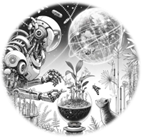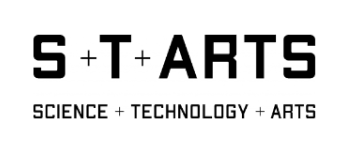Scenario 12: HEALTHY FOOD PROTOCOLS
OPPORTUNITIES
There are opportunities for companies that are involved in urban farming and agriculture technology, sustainable food production and distribution, smart city infrastructure and technology, community development, environmental and ecological sustainability, health and wellness, education, and urban planning and design. Specifically, companies specializing in urban farming solutions, vertical farming systems, hydroponics, and aquaponics could be intrigued by this scenario, while businesses focusing on sustainable agriculture, organic farming, and food distribution systems might get potential ideas for addressing food insecurity. Next, companies offering smart city solutions, including those involved in IoT (Internet of Things), AI, and data analytics for urban planning and management, could find this scenario relevant. Moreover, organizations that specialize in community development, social impact initiatives, education and training in agriculture, and fostering collaboration between residents and local resources may resonate with the vision of community urban farms. Then, companies focusing on health and wellness products and services could see value in this scenario. Finally, companies specializing in urban planning, architecture, and landscape design might be interested in contributing to the design and development of agro-urban communities that prioritize food security, social cohesion, and environmental sustainability.
KEYWORDS
- Urban Farming
- Sustainable agriculture
- Smart City solutions
- Community development
- Environmental sustainability
- Inclusivity
VIDEO
SCENARIO NARRATIVE
The deep political, economic and social crisis has seen Serbia of 2034 as a country of the poor, leaving almost every seventh resident below the minimum survival income. The “Right to Food” protocol has been adopted to enable a sustainable, social and united economy of healthy food chains in big cities by operating within community urban farms.
It deals with concepts, methodologies and technologies to construct an innovative concept of community that aims to empower vulnerable populations by testing different configurations of life, work and farming. What if food can act as a catalyst for societal change and community building?
The scenario introduces several community tech gadgets (brace, brick, balloon, robot bee) from the belief that they contribute to retrieving faith in the concept of community built on ecological, cultural and humanist values of communal living in this hyper-individualized tech world. The scenario envisions the capacities of the collective intelligence of all involved citizens to bring closer the future well-being of the most vulnerable members of our society while allowing them to actively participate in future changes in their local communities and food practices.
Moreover, moving from standard practices of farming to algorithmically generated farms with underlined machine learning and robotic systems, AI technologies enhance the decision-making processes to maintain food security, increase the nutritional value of food, secure the most personalized food consumption model and therefore improve our health and the overall human condition. It is a technology that not only administrates farm infrastructure and enhances the types of necessary data models in support of farm management and types of crop production and responds to a poly-organized farm production area but also contributes to our understanding of the reality of current food production in the city and size-optimization of the city farming.
Scenario developed by Katarina Andjelkovic
TRENDS OF THE SCENARIO
Trend 1
Global trend of establishing circular economy
Circular economy principles provide a framework for alternative community models to create more sustainable, social, and united economies of food chain production by promoting resource efficiency, localized production, sharing and collaboration, value retention and regeneration, resilience and diversity, innovation and adaptation. By integrating these principles into their practices, alternative communities can contribute to building more sustainable and equitable food systems. At the heart of the model is to empower citizens, engage policymakers and industry leaders.
Trend 3
Transforming relationships through food
Transforming relationships through food plays a central role in alternative community models that aim to create sustainable, social, and united economies of food chain production. By fostering community bonds, promoting cultural exchange and understanding, empowering producers and consumers, educating and empowering through food, and addressing issues of food justice and equity, these models contribute to building more resilient, equitable, and interconnected communities.
Trend 5
Integration of vulnerable communities
The integration of vulnerable communities is essential for alternative community models striving to create a sustainable, social, and united economy of food chain production. By promoting social equity and inclusion, empowering individuals, and advocating for policy change, these models can create more equitable, resilient, and thriving communities for all members.
Trend 7
Transition from corporations to communities
The transition from corporations to communities is essential for alternative community models that aim to create a sustainable, social, and united economy of food chain production. By prioritizing local ownership and control, ethical practices, support for local economies, cultivation of social capital, enhancement of food security, environmental sustainability, and democratic decision-making, these models contribute to building more resilient, equitable, and inclusive food systems.
Trend 9
Localized food system
The localized food system plays a vital role in alternative community models by promoting environmental sustainability, supporting local economies, enhancing food security and resilience, preserving cultural heritage, promoting health and nutrition, and empowering communities to make decisions about their food future. By prioritizing local food production and consumption, these models contribute to building more sustainable, social, and united economies of food chain production.
Trend 2
Shift the narrative for food and farming
Commons and commoning, nature-friendly and agroecological practices, regenerative cities, agroforestry, organic farming, regenerative farming, plant welfare, digitized health, arcology (Paolo Soleri).
Trend 4
Integration of the latest technologies
Technology serves as a catalyst in shaping alternative community models for a sustainable, socially inclusive, and united economy in food chain production:
– collectively extracting information via a crowdsourced platform,
– improving regenerative agriculture through open-source technology,
– technology facilitates the creation of digital platforms and apps that enable communities to share resources, knowledge, and surplus produce,
– cloud-connected supply chain: tracking consumption patterns through embedded sensors or blockchain nodes,
– optimizing crop management, improve the supply chain, automate local logistics.
Trend 6
Logistics in alternative community models
Logistics plays a crucial role in alternative community models that contribute to sustainable, social, and united economies of food chain production by facilitating local sourcing and distribution, promoting transparency and traceability, enabling collaborative networks, reducing food waste, engaging the community, fostering adaptability and resilience, and driving innovation and experimentation in the food system.
Trend 8
Opening up land holding
Opening up landholding is essential for alternative community models that seek to create sustainable, social, and united economies of food chain production. By promoting access to land for small-scale farmers, supporting agroecology and sustainable farming practices, facilitating land stewardship and conservation, empowering landless farmers and indigenous communities, creating community farms and gardens, advancing food sovereignty and self-sufficiency, and promoting social and economic equity, these models contribute to building more resilient, equitable, and sustainable food systems.
ELEMENTS OF THE FUTURE SCENARIO
Future portals to the farm scale
Search for the right scale: from kitchen incubator, container box and kiosk size, to the ship, and railway size.
Priority 1: The Urban Planning Institute is planning experimental gardens for educational purposes.
Priority 2: The Urban Planning Institute is planning the implementation of the farm: from urban planning procedures to a design of the structure.
In companion with data analytics specialists, the construction industry partners can plan and predict scenarios based on data. Empowered by AI and the Internet of Things, the basic function is to gather data and calculate the amount of food needed daily for a 1.6 million city (such as Belgrade), and based on these calculations to analyze the scale and most appropriate building typology of community urban farms.
I develop an augmented reality game that hopes to engage local citizens in urban planning and showcase the possibilities for what future community urban farm size, design, disposition in the city and community engagement could look like.
Online cloud “The right to food”
Online Cloud is about creating healthy and equitable communities by allowing all members of the community to actively participate in future changes in their local communities and food practices. The virtual layer of the farm is created that intertwines digital, physical and social layers, selecting and categorizing information from daily activities, and interpreting the information in collaboration with these communities. This could include a sharing economy model where residents exchange excess harvests, fostering a sense of community and reducing food waste.
Such data-driven infrastructure that utilizes generative AI and underlying neural networks can incorporate traditional knowledge – ways of farming, cooking, and working within the community urban farm to monitor, control, enhance ecological performance and contribute to social equity.
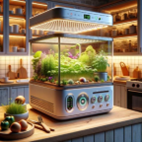
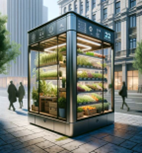


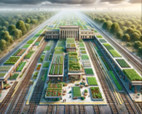



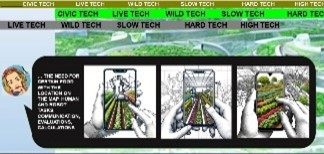

The farm educational center
Members of vulnerable communities learn the agriculture work and farming procedures, how robots work, they listen to stories while the robot serves food and gives instructions about the food traditions, but also learn about the specialties of that commune. Students can experiment practically their latest research in the field of robotics, sensors, Augmented Reality and Artificial Intelligence. Among visitors and enthusiasts, the farm is a place of creating and sharing knowledge about the food system, while children have the opportunity to grow up AI-literate.
Augmented Reality & Mixed-Reality Farming Experiences: for educational purposes, titled “How we live together?” is about learning about the vision of a different co-existence of all creatures and plants as a model for an alternative future. Community urban farms might offer immersive mixed-reality experiences. Visitors wear AR/VR headsets to learn about farming techniques, witness the growth process in real-time, or even simulate hands-on farming experiences in a controlled digital environment.
Life of the community
“The right to food” protocol operates within three defense rings. The life is created around the circular farm and inhabitants are supposed to be self-sustained farmers. This historical configuration resembles the Italian city of Palmanova, a Renaissance city in the shape of a nine-pointed star.
In addition, these farms could be the best solution for aging resiliently in the community: the elderly can practice “do it yourself” farming on the micro level, within a “produce + sell + consume” model for seniors. In company seniors share, cook, shop, eat, and meet together. These farms also include a local cooperative supermarket that offers free deliveries for older people in the neighbourhood. The cooperatives operate smoothly renting homes for migrants, single parents, students and the elderly.
To sum up, this farm can enable a community to become self-sufficient enough to feed and power itself and create consistent jobs catering to the weakest, most vulnerable populations. Its objective is to minimize the need for energy, food and financial resources by implementing a circular economy.




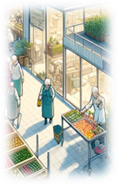
From micro to macro logistics
Micro logistics: Communities’ information ecologies: is about community-centered research. The whole territory of the city is used to map connections of different classes of citizens and their possibilities to meet, co-exist at the same place and work with each other.
Macro logistics: Farm management operates in real and digital space simultaneously by enabling real-time management. A regular missing human workforce in the urban farm is compensated by the use of collaborative robots. Thus, collaborative robots are becoming part of each segment of the services provided: growing vegetables, evaluation and analysis of healthy food empowered by artificial intelligence, agricultural production, food sorting, donating food, collecting and treating local organic waste, housing, the healthy food production, handling with care, food classification and storage, cooking, and contactless food delivery.
Tele-food medicine and tech food control
The brace is a prototype. It is a measuring instrument that provides precise data on one’s physical health: nutrition, disease, and physical activity.
The elderly and the disabled use a brace with embedded sensors that enable the collection of signals and their distribution directly to the online cloud. As part of the fully personalized program, the amount of food and its composition are also measured, allowing remote digital food control for the elderly. In case of need, additional quantities of food are delivered directly from the farm to the home address.
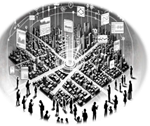
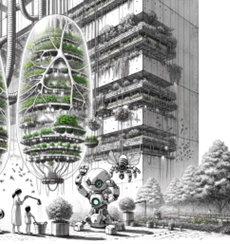
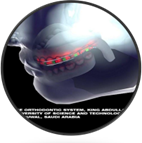

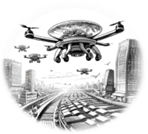
‘Personal gadget’ as ‘community gadget’
‘Personal gadget’ as ‘community gadget’ is becoming an innovative building material. The prototype is a smartphone in the form of the building component – the brick.
The idea is to foster the communal spirit by enabling local citizens to install their own data into the farm building walls and construction elements. In this way, all members of the farm community are becoming farm builders.
The aim is to catalyze real-time internal communication between building sections on the farm and among citizens on a wider city scale. It refers to the information on how to access and use particular resources, as a path to community livelihood made possible based on such access. In this way, buildings can collect, analyze and exchange information in a real-time mode.
Tech-hype community philosophy
The overall goal is to retrieve faith in the concept of ‘community’ built on ecological, cultural and humanist values of communal living in this hyper-individualized tech world. The scenario envisions that communities will retain their role as the place of food-driven relationships that sustain local identities, improve internal care relations, and strengthen the ties between human and non-human creatures (plants and animals). Driven by a holistic approach to a community organization, the aim is to build awareness and faith in a particular community concept, i.e. that the change of policies is accompanied by awareness of values. Community members learn about the vision of a different co-existence of all creatures and plants, along with artificial intelligence, as a model for an alternative future.





